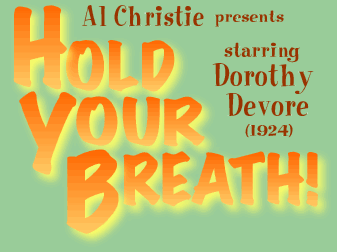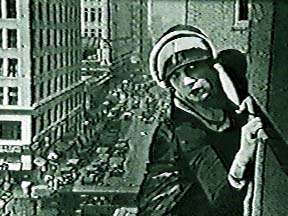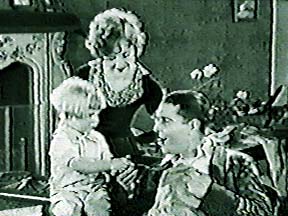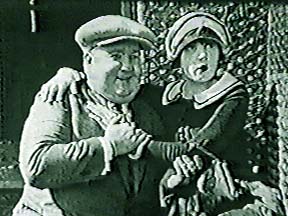

Mabel lives with her brother, Jack, his
wife, Mary, and their small son. Mabel is fired from her job,
and Jack is ordered by his doctor to quit work for two months
because he hasn't fully recovered from being gassed "Over
There." Not only is there no income in the household now,
Jack stands to lose his job permanently if he doesn't  return to work
right away.
return to work
right away.
Suitor Freddie offers to marry Mabel and help out the family, but she refuses to marry him under these circumstances, and, instead, goes to Jack's boss at the newspaper office and offers to fill in for him while he's out sick.
Mabel is sent to get an interview with the reporter-hating millionaire curio collector Blake. Blake has supposedly just brought back a bracelet worth $50,000 from one of his trips. After posing as a bellboy, Mabel succeeds in getting into Blake's apartment and charms him into the interview. However, while looking at the bracelet, an organ-grinder's monkey comes in the window which is several stories above the city street. The monkey grabs the bracelet and dashes out the window. When Mabel tells Blake what happened, he doesn't believe her and calls the house detectives. As they arrive, Mabel goes out the window in hot pursuit of the monkey and the detectives in hot pursuit of her. Thus begins a series of misadventures high above the streets, clinging perilously to ledges, falling through awnings and darting in and out windows.
It is inevitable that any commentary on "Hold Your Breath" (1924) should include references and comparisons to Harold Lloyd's "Safety Last:" (1923) which was released a little over a year earlier. Both are "thrill" pictures whose lead characters end up reluctantly scaling the outside of a tall building as a result of a number of improbable events.
Although "Hold Your Breath" doesn't
suffer because of this comparison, it must be admitted that the
thrills we experience in the final reel of the picture aren't
as exciting as Lloyd's nor does Devore pull off the fear and nervousness
Lloyd conveys so well thereby dampening some of the comic effect.
She does, though, keep the viewer in a mild state of apprehension
throughout her ordeal mixed with some good laughs. To her credit,
the building  climbing sequence doesn't come across
as a direct copy of "Safety Last," and the events which
set the stage for this finale might be a bit more credible than
Lloyd's.
climbing sequence doesn't come across
as a direct copy of "Safety Last," and the events which
set the stage for this finale might be a bit more credible than
Lloyd's.
Fore example, the reason Mabel ends up on the outside of the building is to avoid being arrested by the police for a theft she didn't commit. That's not so hard to believe. Now, the fact that an organ grinder's monkey came in the window several stories up from the street and stole the necklace might be a little hard to swallow, but, hey, even the best movies stretch reality just a little!
Over the years, there has been much conjecture and discussion about just how much of the stunt work Lloyd did in his pictures, particularly in "Safety Last." Author and silent film historian Kevin Brownlow brought an end to the conjecture when he published interviews with stunt man Harvey Parry in the book "Hollywood: The Pioneers" (1979) and his "Hollywood" television documentary (1980). Parry told how he doubled for Lloyd in the long shots and how a fake building façade would be constructed on the roof of a tall building to give the semblance of great height without the danger. So, it stands to reason that Devore isn't doing all of her stunts in "Hold Your Breath," nor do we expect her to. But, isn't it a little more difficult for a stunt "man" to double for Devore who is wearing a dress than it would be for a male comedian such as Lloyd? All of this is handled very ingeniously by Christie.
Devore must impersonate a bellboy in order to get into Blake's apartment. When she goes back to put on her dress, she leaves the man's long pants on underneath! Also, with a hat of the "pull down" style worn in the twenties, it is easy to hide the face from the camera, as well. It is obvious that her decision to continue wearing the pants was a ploy to disguise whoever was doing her stunt doubling for her!
It is interesting to note a couple of original
'thrills" in "Hold Your Breath" that pop up in
Lloyd's 1930 remake of  "Safety Last" entitled "Feet
First." One of these is when Devore falls onto an open awning.
It rips, and she falls backward through the torn material hanging
upside down by her legs. Remember this in "Feet First"??
Also, she falls backward out of a window while trying to grab
onto a fire hose that keeps unraveling from its spool. This, too,
was a gag that appeared in "Feet First."
"Safety Last" entitled "Feet
First." One of these is when Devore falls onto an open awning.
It rips, and she falls backward through the torn material hanging
upside down by her legs. Remember this in "Feet First"??
Also, she falls backward out of a window while trying to grab
onto a fire hose that keeps unraveling from its spool. This, too,
was a gag that appeared in "Feet First."
We shouldn't bypass giving some credit to the first three-quarters of the film. As noted earlier, the sequence of events that bring about Devore's building climbing escapade are adequately believable, and there is some mild tugging at the heartstrings thrown in, too. A dash of pathos is injected into this comedy because of the financial crisis that hits Mabel's household when her brother can't work, the wife has apparently given away their life savings to a crooked oil company salesman, and Mabel has lost her job, too. From this point on, though, any sentimentality is left behind in favor of the comedy.
Christie comedies weren't quite as "exaggerated" in their characterizations or situations as Keystone or even Roach, for that matter. Not to say they couldn't stretch reality pretty far, but whereas most other comedy producers of the era may rely on grotesque make-up for comedic effect, Christie put more emphasis on the situations. The comedies certainly had their share of slapstick, but "Hold Your Breath," like the traditional Christie comedy, could never be compared with an early Keystone.
 In one sequence where Mabel is trying
to see over a crowd that has gathered around a plane crash, she
is pushed backward into an empty baby buggy. This rolls backward
into the street and becomes attached to the bumper of a car. Of
course the car darts forward at that very moment, and off she
goes being pulled behind a speeding car with legs and arms waving
furiously.
In one sequence where Mabel is trying
to see over a crowd that has gathered around a plane crash, she
is pushed backward into an empty baby buggy. This rolls backward
into the street and becomes attached to the bumper of a car. Of
course the car darts forward at that very moment, and off she
goes being pulled behind a speeding car with legs and arms waving
furiously.
In spite of this type of sequence, Christie comedies didn't relegate their comedy solely to the physical gags. For one thing, a great deal of emphasis was placed on humorous titles, possibly with a little more success than most.
For example, rotund Walter Hiers plays Mabel's (Devore's) boyfriend, Freddie. We are introduced to him as he works before daylight to finish his and Mabel's home-to-be. The titles explains, "Freddie has Mabel's promise to marry as soon as their bungalow's finished, so he's trying to reduce his wait."
A contemporary biography says Hiers began
his career with D.W. Griffith around 1913. The American Film
Institute Catalog lists Hiers' first feature as "Just
Out Of College" in 1915. In addition to the many short comedies
he made, Hiers appeared in over 70 features during the silent
era. Many of these appearances are in small roles that don't give
him star status, but he was obviously much in demand during the
silent era. Hiers was not your typical "physical" fat
man as was seen in so many silent comedies. His character was
usually more genial and gentle. Unfortunately, though, he never
achieved star status and isn't remembered high on the list of
silent movie comedians.
Tully Marshall, on the other hand, who doesn't have a really big role in "Hold Your Breath," was a very accomplished actor with some excellent portrayals to his credit during the silent era. Who could forget his excellent portrayal of Bridger in "The Covered Wagon" (1923) playing alongside Ernest Torrence as Jackson. How great it would have been to see the two of them co-starred as these characters in more westerns! He could also portray one of the most menacing characters on the screen, too. Just take a look at him as Louis XI in "The Hunchback of Notre Dame" (1923) or as Count Mancini in "He Who Gets Slapped" (1924). As Blake, the ornery curio collector, he does very well, but it certainly isn't a role that does justice to this fine actor.
Dorothy Devore is the star of the picture, however, and a very pretty and capable one at that. She made almost 25 features during the 1920's in addition to many two-reelers during that decade and in the 'teens. She was the top female comedian on the Christie lot for much of this time with a perky, lively and charming personality on screen. Silent film historian and author Anthony Slide commented that she was "perhaps a little too charming to make it into the major leagues of screen comediennes." "Hold Your Breath" is fairly early in her career, and she is at her most charming here. She balances attractiveness, femininity and her comedic talents very well making her performance most enjoyable.
The saddest thing about this film is that it apparently only survives in a 33-minute version, much reduced from an original running time of an hour or more, depending on the speed at which it was intended to be projected. The American Film Institute Catalog of Feature Films 1921-1930 lists the film length as 5,900 feet, which, at a minimum of 10 minutes per reel would be 59 minutes. Because the film holds together well and doesn't seem to have any glaring "holes" in the continuity, it can be assumed that this version was trimmed down at some later time for a re-release.
Speaking of continuity, we do have some questions when Mabel is driven to work by Freddie and returns home later to say she was fired. We never see where she went nor are we given any clue as to the type of job she had. The description in the AFI Catalog makes reference to her job at a beauty parlor, but we never see that in this version of the film.
"Hold Your Breath" is nevertheless a very enjoyable film giving little hint that approximately 27 minutes are missing. Admittedly, it is not going to end up on anyone's top 10 list of silent comedies, anyway, but it is also not going to end up at the bottom of the pile. It is, however, very representative of the silent movie comedies of the twenties, and, being a "thrill" picture, it is right in vogue for the period.
All contents copyright 2001 by Tim Lussier, all rights reserved.